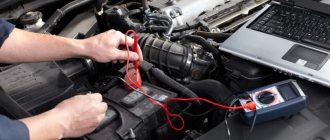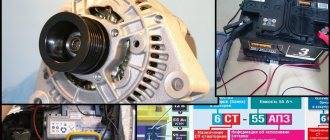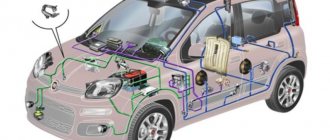The engine, starter, generator and battery always have an increased load, which often leads to rapid battery discharge and the inability to start the car. Often in such a case, car owners think about whether it is possible to charge the battery without removing it from the car and without removing the terminals. Let's talk in more detail about whether it is possible to charge the battery in this way or whether this can lead to serious malfunctions.
Features of battery charging
Experienced car owners will invariably assure that the battery can only be charged at home in a warm place, using appropriate rectifiers. However, the use of modern chargers can significantly simplify such work. Therefore, any difficulties with recharging the battery in a car, if you do not remove the terminals and the battery is connected to the on-board network, are guaranteed not to arise. That is why garage owners do not have to dismantle the battery; they can simply connect the charger for a certain time, which will solve the problem with a dead battery.
At the same time, when choosing such an express charge, you need to remember that today all cars are usually divided into two types: carburetor and injection. The latter are most widespread today, due to their versatility, power and efficiency. But old carburetor-type engines are practically never seen today and are considered obsolete.
The procedure for charging the battery without removing it from the car
Charging a car battery is a fairly simple procedure, or at least most owners think so. However, in reality, everything is a little more confusing and complicated, since incorrect actions in this direction can lead to very sad consequences, the repair of which will cost tens of thousands. If you go to charge the battery, but do it incorrectly, it can deteriorate, catch fire, or worse, explode and destroy other parts that are nearby in the engine.
The climatic conditions in our country are such that few people use the battery for its intended purpose and in accordance with the manufacturer’s recommendations. The fact is that a battery can break in several cases: when it is undercharged or when it is overcharged. Accordingly, if the weather is cold outside and the charge level is low, this can lead to a change in the polarity of the cans inside the battery. On the other hand, at high temperatures and an overcharged battery, the positive plates are destroyed, which leads to a decrease in weight. In general, unconscious and incorrect actions have a detrimental effect on the condition of the device, and therefore it is extremely important to properly charge the battery.
Prerequisites for charging the battery in a car
If previously no special questions arose when it came to recharging the battery for a car, today everything is becoming more complicated. In the past, cars were simple and did not have a huge amount of electronics and other complex systems, which cannot be said about modern cars.
Therefore, charging was reduced to the fact that the battery was dismantled, taken home or left in the garage and connected to a regular charger. Moreover, it was possible to recharge the battery just a little so that it was enough to start the engine, and further charge was replenished due to the operation of the generator.
New, advanced cars are equipped with on-board computers, a variety of sensors, control systems and much more that work solely by connecting to the network. In this case, removing the terminals and disconnecting the battery becomes dangerous and unprofitable.
This is explained by the fact that a lack of power will lead to resetting all settings (climate control, steering wheel, seats, audio system), deleting various information about the system, diagnostic data, etc.
All this will need to be restored and reconfigured, and it is not always possible to do this on your own, so you have to turn to specialists for help. Moreover, some equipment, such as advanced audio systems, may require an operating system update after being disconnected from power.
Considering all these inconveniences, as well as possible financial costs, the desire to charge the battery without removing it from the car began to appear among many.
Features of the charging process
In order to charge a car battery without removing it, you must follow certain rules. This will allow you to avoid possible damage and ensure that the battery is recharged and will last for a very long time. So, charging the battery without removing it from the car requires following these recommendations:
In general, that's all. As for the process itself, charging the battery without removing it from the car is practically no different from the usual version. The fact is that in this case there will be a large number of different objects near the battery that can conduct current. Moreover, if by accident you slam the hood and this leads to a short circuit of the terminals, then the consequences of this will be very unpleasant, and also expensive. Therefore, you need to connect charging to the battery on the car when it is disconnected from the network or when the current is at a minimum level.
Charging the battery should begin by connecting to the charger, and then gradually increase the level of the supplied current. That is, all actions should be aimed at maximizing and preventing possible voltage surges. It is also important to ensure good and firm contact between the device and the terminals.
Of course, most of these measures are aimed at safety and reinsurance. However, if you remember how much controllers and other elements that can burn out cost, you realize that it is worth it.
Battery Maintenance
In order for the battery to work for a long time and not fail at the wrong time, it must be used correctly, as well as preventive operations. Typically, the lifespan of a car battery is between 5 and 10 years. By following these recommendations, you can maximize the time of its use:
- Periodically (every quarter) check the battery voltage, monitor the electrolyte level and its density, wipe the outside of the battery and clean the terminals to avoid self-discharge problems.
- When storing the battery for a long period of time without use, place it in a cold room to slow down the chemical reactions, since they are directly dependent on temperature. Charging and discharging is also necessary.
To do this, you may need a special plug to monitor the battery voltage, as well as a charger.
I would like to separately note the choice of charger. In order to charge the battery without removing it from the car, you need high-quality and reliable equipment. As a rule, there are two types of chargers: constant current and constant voltage. As for their capabilities for maintaining battery performance, they are, in general, equal. However, despite this, each of them has its own advantages and disadvantages.
For example, if charging is carried out using a device based on direct current, then constant monitoring and adjustment of the supplied current is necessary. This is not very convenient, since if the entire process for a 60 A/h battery takes 20 hours, then you will have to pay attention to the instrument readings every 2 hours. A device with constant voltage is more convenient and profitable, which does not require your attention and is identical in charging time.
In general, charging the battery directly on the car is quite simple. The main thing is to always follow safety precautions and follow all the tips given in our article. Also, always pay attention to the instructions for the device and the characteristics of your battery to avoid possible breakdowns.
How to charge the battery without removing it from the car Charging the battery without removing it from the car How to charge the battery? How to start the engine if your battery is dead Starting the car engine using a jump charger How to start a car with a dead battery Our readers recommend the HD Smart car DVR. This device will help you in controversial situations and save on fines! The DVR has a built-in night mode, motion sensors, films in FULL HD/ And most importantly - no prepayment! Read more here...
Similar articles
(voted:5, rating: 3.40 out of 5) 03/19/2016 Top Gear Russia Author
kiarioinfo.ru
High quality charger
The efficiency of battery recharging and the complete safety of such work will depend, first of all, on the correct choice of charger. Indeed, such rectifiers, made independently in makeshift conditions from low-quality components, will not be able to produce the correct voltage. This can lead to damage to electronic components, and their subsequent repair and replacement will be extremely expensive.
Therefore, to charge the battery in this way directly on the car, you should use a device that produces a voltage of no more than 15 Volts. But if the voltage indicator jumps and reaches 17-18 Volts, then this is critical for most automotive electrical systems. Car owners can only be advised to use high-quality factory-purchased chargers, and not try to do them themselves, which can lead to a subsequent reboot of the battery and damage to the car’s on-board network.
Is it possible to charge a battery without removing the terminals?
Motorists who do not have the opportunity to install a second parallel battery, and do not want to configure the car’s standard systems again, try to charge the battery without removing the terminals from it. It is difficult to find reasonable explanations online about whether a battery can be charged when it is connected to the car’s electronic system, and debates regularly flare up on this issue. There is no clear answer to the question; however, there are reviews both about the successful charging of the battery in a car without removing the terminals, and about serious problems that arose during such actions. We propose to consider the charging process from the point of view of the theory of electricity in order to obtain the most correct answer to the question posed.
The main problem that may arise when charging a car battery included in the on-board system is overvoltage. If the maximum voltage of automotive electronic devices is exceeded, they may completely fail, and all that remains is to replace them. Each model of automotive electronics has its own parameters for the maximum tolerated voltage. It is ideal if the car owner who plans to charge the battery without removing the terminals knows the minimum value of the maximum permissible voltage among all electronic systems of the car. If we take the average value, we can say that most automotive devices can withstand overvoltage up to 15.3-15.7 Volts.
Based on the maximum voltages for automotive electronic devices, the charger should be selected according to its output parameters. When purchasing certified high-quality equipment from a reputable manufacturer, you can look at the output electrical parameters in its technical data sheet. Based on them, it is concluded that it is possible to charge the battery without removing the terminals.
Attention: When purchasing a car battery charger from a little-known brand, there is no guarantee that the technical data sheet contains correct information about the electrical parameters. There are many chargers on sale, the voltage of which reaches 17-18 Volts constantly or in the form of short-term pulses. By charging the battery without removing the terminals, there is a high risk of damaging the vehicle's electronic system equipment.
Article on the topic: What to consider when choosing engine oil
Some manufacturers of car battery chargers install special overvoltage protection systems. Thanks to their use, if problems arise with charging operation, the maximum charging voltage will not exceed that declared by the manufacturer (or set by the user). Charging the battery without removing the terminals using such stations is completely safe, while when using no-name equipment or homemade chargers, you should think again - wouldn’t it be easier to reconfigure the car’s electronic devices in order to protect the on-board system from overvoltages and possible failure of expensive equipment.
Recharging the battery on a carburetor and injection engine
Recharging batteries on old carburetor cars is not difficult, and there is no need to remove the battery, since such cars practically do not have any built-in automation. But with recharging batteries in a car that uses an injection engine, not everything is so smooth. There is an erroneous conclusion that if you connect a rectifier to a battery with the terminals not removed, this will invariably lead to failure of the electronic engine control unit.
However, this is often not always true, since on most cars, if the ignition in the car is turned off, the electronic control unit is de-energized and, by connecting a rectifier to charge the battery, it will be impossible to disable the electronic brains of the engine. Most modern cars have excellent protection against power surges. Let us only repeat that for such recharging without removing the terminals directly on the car, you should choose only high-quality chargers in which the voltage does not exceed 15 Volts. In such a case, you can charge the battery without any problems, and there is no need to remove it from the car.
Parallel connection of the second battery to the car
When it is necessary to remove the battery from a car, electricians often use the following method to prevent the car’s electronic system from resetting its parameters:
- A 12 Volt battery is taken, which is sufficiently charged to support the car’s electronic system in offline mode;
- Using special wires, the battery is connected in parallel to the terminals of the car;
- Next, the main battery is turned off, but the machine’s electronic system continues to be powered by an additional energy source.
By replacing the battery in your car, you can easily charge the main battery and then return it back. The complexity of this method is that the car owner does not always have a spare battery and wires for parallel connection of an additional power source.
Article on the topic: The importance of the dashboard
Is it possible to charge the battery directly on the car?
Vit. wrote: The charger produces the same 12-14.5 volts as the generator
Did you understand what you said? The normal charging voltage is 14.5 Volts and only this, if someone has 12 Volts, then nothing will charge and the charging system is clearly faulty.
Vit. wrote: How can this harm the “brains”?
The charger produces not 12-14.5 Volts, but much more. The output voltage of chargers is usually not stabilized, that is, without a load (connected battery) there may well be 20-30 volts at the terminals, and this voltage at the moment the battery wires touch is already dangerous for automotive electronics.
I’ll tell you why it’s forbidden to remove the terminal. Of course, this rule does not apply to service personnel in a car service center and is intended only for car owners, so that the latter do not create unnecessary problems for themselves and the car service center. There is an exception; it is strictly forbidden to remove the terminal while the engine is running or the ignition is on, similarly, if you can hear the operation of any systems or servos of the car. Why? The battery charging system in a car does not stabilize the voltage, that is, a running generator can produce voltage up to 80 volts. We removed the terminal with the engine running, and there was 80 Volts and hello to electronics. Car computers have some power protection, but more often than not, such a high-voltage pulse is enough to burn out the electronics or damage the RAM. The battery serves as a load for the generator, even if it is faulty and discharged to zero, it still limits the voltage developed by the generator, of course, if the battery itself physically maintains its integrity. That is, I warn you once again not to disconnect the battery under any circumstances when the engine is running! Turned off the ignition. Okay, but this does not mean that all vehicle systems are stopped. If the engine is still hot, the fan and cooling pump may turn on, even two minutes after stopping the engine. If the power supply to the pump is lost, the cooling will be disrupted and it can lead to headaches; this is easy for the Japanese. Also at this moment, the dampers may close or auto-calibration of the power supply or automatic transmission control systems may occur or end. If you pull off the terminal, the servo drive will simply freeze and then may not return to its proper place, it will consume fuel or the dynamics will disappear or something else will start to work incorrectly. Therefore, it is recommended to wait two or three minutes and only then use the keys to remove the terminals.
Can modern batteries cause harm?
Problems with recharging can only arise if you choose a low-quality, homemade or outdated charger.
If you choose the wrong charger, the voltage may be too high, which will cause electronic devices to burn out, even if you first disconnect them from the ignition switch.
The on-board network is designed for no more than 15 V, and 16-17 V will be critical for the car’s electronics.
It will be better if you use a certified charger with several levels of protection: it will control the voltage supplied to the battery and overcharging will not occur.
It is not worth charging the battery separately, since all modern cars are full of electronics that remember the settings in the car. If you remove the battery, these settings will be reset and will have to be restored.











